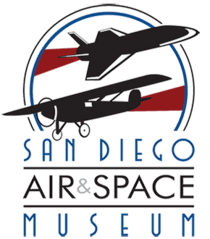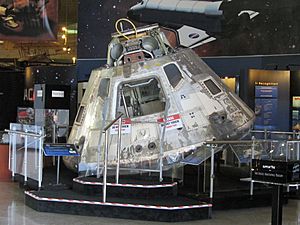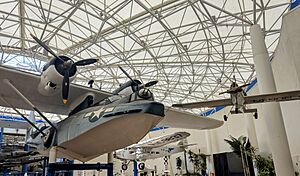- This page was last modified on 9 August 2025, at 21:13. Suggest an edit.
San Diego Air & Space Museum facts for kids
 |
|

Museum entrance in 2009, with a Convair YF2Y-1 Seadart on the left and a Lockheed A-12 Oxcart on the right.
|
|
| Lua error in Module:Location_map at line 420: attempt to index field 'wikibase' (a nil value). | |
| Former name | San Diego Aerospace Museum |
|---|---|
| Established | October 12, 1961 |
| Location | Ford Building 2001 Pan American Plaza San Diego, California, US |
| Type | Aerospace museum |
| Accreditation |
|
| Key holdings |
|
| Collections |
|
| Visitors | 270,000 (FY 2017) |
| Public transit access | Bus 7, Rapid 215 |
| Nearest parking | On site (free) |
The San Diego Air & Space Museum (SDASM) is an exciting museum in San Diego, California. It is all about aviation (flying) and space exploration. You can find it in Balboa Park, inside the historic Ford Building. The museum officially started on October 12, 1961, and first opened its doors to visitors on February 15, 1963.
Contents
Museum History
The museum began on October 12, 1961, and was first called the San Diego Aerospace Museum. It opened to the public on February 15, 1963. The first location was the Food and Beverage Building, built in 1915. In 1965, the museum moved to a bigger place called the Electrical Building.
On February 22, 1978, a sad event happened. The Electrical Building and the museum inside it were destroyed by a fire. Many unique aircraft were lost. This included the Beecraft Wee Bee, which was the lightest aircraft in the world. A copy of the famous Spirit of St. Louis airplane was also destroyed. More than 50 other aircraft and many historical items were lost.
Even before the fire, there were plans to move the museum to the larger Ford Building. This building was also in Balboa Park. Luckily, many new aircraft the museum had collected were in storage. They were waiting for space in the new building and were saved from the fire. The community helped by raising money and donating items. The museum reopened in its current home, the Ford Building, on June 28, 1980. New copies of the Spirit of St. Louis and the Wee Bee were built for the new museum.
In 2005, the museum became connected with the Smithsonian Institution. This is a special honor, as only a few aerospace museums in the country have this connection.
Explore the Exhibits
The museum has many different areas, called galleries. These exhibits show how San Diego has helped aviation grow. You can explore the Theodore Gildred Rotunda, special exhibit areas, and galleries for different time periods. These include World War I, the Golden Age of Flight, World War II, and the Modern Jet & Space Age. There is also the Edwin D. McKellar Pavilion of Flight. You need a ticket to enter, and some special exhibits might cost extra.
The museum also has a restoration shop. You can sometimes take tours to see how old aircraft are brought back to life.
Theodore Gildred Rotunda

The Apollo 9 Command Module Gumdrop flown in 1969 by James McDivitt, David Scott, and Rusty Schweickart in preparation of the first lunar landing missions
When you first enter the museum, you will be in the Theodore Gildred Rotunda. Here, you can see the Apollo 9 Command Module Gumdrop. This spacecraft flew in 1969 to prepare for the first moon landing. This area also shows examples of aircraft made by companies in San Diego. You will see original planes, models, and even flying copies of famous aircraft. Some examples include the Montgomery 1911 Evergreen glider and a copy of the Spirit of St. Louis.
Special Exhibits
Beyond the main entrance, you will find special exhibits that change over time. Look up as you walk through this area! You will see many early aviation exhibits hanging from the ceiling. If you do not pay for the special exhibit, you can walk through the International Air & Space Hall of Fame hallway. This hallway has pictures of famous aviation pioneers. You can also learn about Jacqueline "Jackie" Cochran and the Women Airforce Service Pilots.
Hanging above this area are models and reproductions of early flying machines. These include designs by Leonardo da Vinci and gliders from pioneers like Otto Lilienthal.
World War I Gallery
This gallery takes you back to the time of World War I. It looks like a boardwalk and a tent, similar to those used by pilots then. You can see copies of famous planes like the Albatros D.Va and the Fokker Dr.I. There are also real planes like the SPAD S.VII.c.1 and Nieuport 28. A cool display shows how a special gear allowed pilots to shoot through their propellers without hitting them. You can even press a button to see how it worked!
Golden Age of Flight Gallery
This gallery celebrates the "Golden Age" of flying, a time of exciting new aircraft designs. You will see many planes on the floor and hanging from the ceiling. Some aircraft here include the Lincoln Standard J-1 and the Piper J-3 Cub.
The museum also displays several aircraft engines from this period. These engines powered many of the planes you see.
You can also find the Education Center in this section. This is where the museum hosts fun Family Day activities each month. The museum's restrooms are also located here.
There is an exhibit about Pacific Southwest Airlines (PSA), also known as the Poor Sailor's Airline. You can see a copy of their first ticket office. It also shows flight attendant uniforms from the 1950s to the 1980s.
World War II Gallery
This gallery features aircraft from World War II. A recent addition is a copy of the Horten Ho 229 flying wing. This unique aircraft was given to the museum by Northrop Grumman.
Other planes in this section include a Stearman N2S-3 Kaydet and a North American P-51D Mustang. You can also see a copy of the Messerschmitt Bf 109G-14 and a Supermarine Spitfire Mk.XVI.
This area also has a model of the USS Yorktown (CV-10), an aircraft carrier. Many Navy planes are displayed around it, like the Douglas SBD-4 Dauntless and the Grumman F6F-3 Hellcat. You can even see a Mitsubishi A6M7 Zero-sen flying low over the deck.
Modern Jet and Space Age Gallery
This gallery showcases modern jet aircraft and space exploration. You can see a Douglas A-4B Skyhawk and the F/A-18A Hornet "Blue Angel 1". There is also a copy of a Gemini spacecraft and an Apollo Command and Service Module mock-up.
At the end of the gallery, you will find the Boeing GPS-12 Satellite. This was a backup satellite that was ready to be launched if needed. When newer satellites were made, this one was donated to the museum.
You can also see the cockpit canopy of the North American X-15. This was a super-fast rocket plane. Many astronauts who grew up in San Diego are also highlighted here, like Wally Schirra. He was the only astronaut to lead missions in Mercury, Gemini, and Apollo programs.
Edwin D. McKellar Pavilion of Flight
This large area was once a showroom for cars. Now, it holds many of the museum's biggest aircraft. These include the Consolidated PBY-5A Catalina, a Mikoyan-Gurevich MiG-17, and a Ford 5-AT-B Trimotor. You can also see a copy of the Beecraft Wee Bee and some racing aircraft.
The McDonnell Douglas F-4J/S Phantom II on display here was flown by famous pilots Duke Cunningham and William P. Driscoll during the Vietnam War. This plane has both radar-guided and heat-seeking missiles.
Outside the Museum
Right outside the museum entrance, you can see two impressive aircraft. These are a Lockheed A-12 and a Convair YF2Y-1 Sea Dart.
Gillespie Field Annex
The museum also has another location called the Gillespie Field Annex in El Cajon. This annex has more space for aircraft displays and restoration work. Some of the aircraft you can see here include:
- Convair F-102A Delta Dagger
- Mikoyan-Gurevich MiG-15bis
- Grumman F-14 Tomcat
- General Dynamics F-16 Fighting Falcon
- Bell UH-1 Iroquois
- Ryan X-13 Vertijet
- SM-65 Atlas missile
- North American F-86F Sabre
- Mikoyan-Gurevich MiG-21bis
An F-14 Tomcat from this annex was even used in the movie Top Gun: Maverick.
Museum Collection
The San Diego Air & Space Museum has many original and copied historic aircraft and spacecraft.
- Lockheed A-12 Oxcart
- Bowlus SP-1 Paper Wing – replica
- Convair YF2Y-1 Sea Dart
- Apollo 9 command module Gumdrop
- Spirit of St. Louis replica
- Curtiss A-1 Triad
- General Atomics MQ-1 Predator UAV
- Ryan Firebee
- Northrop Grumman RQ-4 Global Hawk (1/2 scale model)
- 1902 Wright Glider (reproduction)
- Wright Flyer (reproduction, not currently on display)
- Vin Fiz Flyer (reproduction)
- Ford 5-AT-B Trimotor
- Supermarine Spitfire LF Mk.XVIe
- North American P-51D Mustang
- SPAD S.VII.c.1
- Nieuport 28
- Curtiss JN-4D Jenny
- North American F-86 Sabre (at Gillespie Field annex)
- Mitsubishi A6M7 Model 63 Zero
- Grumman F-14 Tomcat (at Gillespie Field annex)
- Mikoyan-Gurevich MiG-17
- McDonnell Douglas F-4S Phantom II
- Bell AH-1E Cobra
- PBY-5A Catalina
- Horten Ho 229 (model)
- P-26 Peashooter (currently on display)
- Vought F4U-7 Corsair (currently on display)
The museum is known as one of the largest aviation museums in the country. It also has one of the biggest collections of historical documents and photos about aircraft. The museum has two places where they restore old planes: one at the main museum and another at Gillespie Field. The Gillespie Field Annex is open to the public. It has many aircraft outside, a Convair SM-65 Atlas missile, and a restoration shop. The museum's library has many books and old photos about planes and how they were made.
Special Events
The museum often hosts talks, programs for students, and other special events. You can even rent the Pavilion of Flight for your own event or dinner.
See also
 In Spanish: Museo aeroespacial de San Diego para niños
In Spanish: Museo aeroespacial de San Diego para niños
- USS Midway Museum – Another air museum in San Diego, which is a former aircraft carrier turned museum ship.
- List of aviation museums











